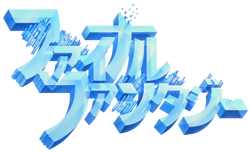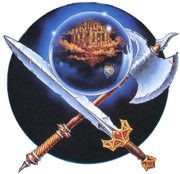No edit summary Tag: Visual edit |
HarpieSiren (talk | contribs) (Undo revision 1919075 by 108.236.15.12 (talk)) |
||
| Line 50: | Line 50: | ||
| platforms = [[Nintendo Entertainment System]], {{w|MSX2}}, [[WonderSwan Color]], [[PlayStation]], [[Game Boy Advance]], {{w|FOMA|NTT DoCoMo FOMA 901i}}, [[PlayStation Portable]], {{w|Virtual Console|Wii Virtual Console}}, [[PlayStation Network]], J2ME Phones (released by Namco Games), [[iOS]], {{w|Windows Phone}} |
| platforms = [[Nintendo Entertainment System]], {{w|MSX2}}, [[WonderSwan Color]], [[PlayStation]], [[Game Boy Advance]], {{w|FOMA|NTT DoCoMo FOMA 901i}}, [[PlayStation Portable]], {{w|Virtual Console|Wii Virtual Console}}, [[PlayStation Network]], J2ME Phones (released by Namco Games), [[iOS]], {{w|Windows Phone}} |
||
}} |
}} |
||
| − | :<small>''This article is about the |
+ | :<small>''This article is about the first installment of the series. For general series information, see [[Final Fantasy (Series)]]. For other uses, see [[Final Fantasy (Disambiguation)]].''</small> |
'''''Final Fantasy''''', also known as '''''Final Fantasy I''''' or '''''the Original Final Fantasy''''' in collections and common languages, is a role-playing game developed and published by [[Square Co., Ltd.]] for the [[Nintendo Entertainment System]]. It was released in 1987, and it is the inaugural game in Square's flagship ''[[Final Fantasy (Series)|Final Fantasy]]'' series. ''Final Fantasy'' was [[Nobuo Uematsu]]'s sixteenth work of video game music composition. |
'''''Final Fantasy''''', also known as '''''Final Fantasy I''''' or '''''the Original Final Fantasy''''' in collections and common languages, is a role-playing game developed and published by [[Square Co., Ltd.]] for the [[Nintendo Entertainment System]]. It was released in 1987, and it is the inaugural game in Square's flagship ''[[Final Fantasy (Series)|Final Fantasy]]'' series. ''Final Fantasy'' was [[Nobuo Uematsu]]'s sixteenth work of video game music composition. |
||
Revision as of 01:06, 23 June 2014

Oh, shut up and help me remodel the Final Fantasy page!
Template:Sideicon Template:Infobox CVG
- This article is about the first installment of the series. For general series information, see Final Fantasy (Series). For other uses, see Final Fantasy (Disambiguation).
Final Fantasy, also known as Final Fantasy I or the Original Final Fantasy in collections and common languages, is a role-playing game developed and published by Square Co., Ltd. for the Nintendo Entertainment System. It was released in 1987, and it is the inaugural game in Square's flagship Final Fantasy series. Final Fantasy was Nobuo Uematsu's sixteenth work of video game music composition.
Since the original creation of Hironobu Sakaguchi, Final Fantasy has subsequently been remade for several different video game consoles and handheld systems, including the MSX2 computers (converted and released by Microcabin) and the Bandai WonderSwan Color. It has also seen versions produced for two Japanese mobile phone service providers: the NTT DoCoMo FOMA 900i series (as Final Fantasy I) and the CDMA 1X WIN-compatible W21x series of mobile phones from au/KDDI (as Final Fantasy EZ) and has also been made available with the American mobile company, Sprint and the Canadian mobile company, Rogers.
The game has frequently been packaged with the next game in the series, Final Fantasy II. Compilations of the two games have been released for the Family Computer, the PlayStation, and Game Boy Advance. Most recently, the game was released on Windows Phone as an Xbox Live title. The two have also been released separately for iOS.
Gameplay
- Please note, the following refers to the original Famicom/NES version. For changes in subsequent remakes, see the sections on Development.
Final Fantasy begins by asking the player to select the character classes and names of each Light Warrior (The player characters). Just like most computer role-playing games of that era, the player characters are passive participants in the story. Because of this, the player's choice of character class will only affect the Light Warriors' abilities in battle.
The character types are:
- Warrior (Fighter) — A specialist in heavy weapons and armor who can withstand tremendous amounts of punishment. Can become the Knight later in the game, who is able to use the most powerful weapons and some White Magic spells.
- Monk (Black Belt) — A martial arts expert who is best left fighting empty-handed, but may also wield nunchaku, and the most basic of staves. Does tremendous amounts of damage in combat, but cannot wear heavy armor. Can become the Master later in the game. In the original Famicom/NES version a high level, barehanded Master who is unencumbered by armor, can do more damage in a single attack than any other character type; a party of four Masters can defeat the final boss monster in less than two full rounds. A rather weak class in the beginning, but you never have to buy much weapons/armor for him.
- Thief — A high evasion/accuracy finesse fighter with very limited weapon and armor selection, but greater agility and luck (ability to escape from combat). However, the ability to flee is bugged in versions before the Origins release. Later in the game, the Thief can be upgraded to the Ninja class. Ninja can use almost every weapon and most armor, and can use many Black Magic spells.
- White Mage — A specialist in White Magic. Not a good fighter, but can use hammers for physical attacks. Can be upgraded into a White Wizard, which allows the character to use the most powerful White Magic spells in the game.
- Black Mage — A specialist in Black Magic and a very weak fighter. Becomes the Black Wizard later on. Black Wizard is the only character who can cast Flare (NUKE in the original North American localization), one of the two damaging spells that retain full effectiveness against Chaos (the White Wizard can cast Holy, the other spell, but it is less powerful than Flare).
- Red Mage — A jack-of-all-trades character, able to use most but not all of both White and Black Magic, and possessing fighting abilities similar to but not quite as good as the Fighter. Becomes the Red Wizard later in the game.
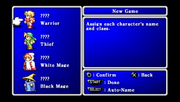
Naming a character (PSP version).
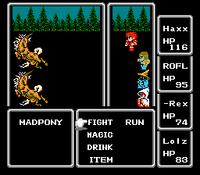
A battle in the NES version against two MADPONY, later translated as Crazy Horse.
Gameplay is similar to that of many other console role-playing games. The player wanders around a World Map, randomly encountering monsters which must be either dispatched in battle or fled from. Emerging victorious in battle earns the player Gil, which can be used to buy weapons, armor, curative items, and magic spells.
Victory also grants Experience, which accumulate until players achieve certain milestones ("experience levels") at which characters gain greater capacity for strength, damage resistance (known as Hit Points, or HP), and spell casting. The player can enter towns on the world map to be safe from random attacks, restore HP and spell charges, acquire information by talking to villagers, and shop. Battle is turn-based, i.e. players select the desired actions for their PCs (Fight, Cast Spell, Run, etc.), and when finished the PCs execute their actions while monsters retaliate depending on their Agility.
Every version of Final Fantasy also has a secret minigame, 15 Puzzle, that can be played out on the sea.
Story
And so their journey began. The four Warriors of Light felt overwhelmed by the great task destiny had placed upon them. They did not know the true significance of the four crystals they held in their hands... The crystal that once, long ago, shone with a light so brilliant. The time for their journey had come. The time to cast off the veil of darkness and bring the world once more into the light...
Final Fantasy opening scene
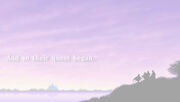
The Light Warriors begin their quest.
Final Fantasy takes place in an unnamed fantasy world with three large continents. The world's elemental powers are determined by the state of four glowing crystals ("orbs" in the original North American localization), each governing one of the four classical elements: earth, fire, water, and wind.
About four centuries before the game starts, a group of people known as the Lufenian used the wind crystal's power to craft a giant aerial station ("Flying Fortress") and airships, and watched their country decline as the wind crystal went dark. Tiamat, the fiend of wind, waged a battle against them, taking over their flying fortress and the Mirage Tower. A Lufenian called Cid hid an airship on the south continent.
About two centuries before the start of the game, Kraken, the fiend of water, used violent storms to sink the water shrine that served as the center of an ocean-based civilization to use it as his personal hideout and to darken the water crystal.
Shortly before the start of the game, Lich, the fiend of earth, darkens the earth crystal and plagues Melmond as the plains and vegetation decay. On an unspecified point, a sage called Lukahn tells of a prophecy that four Warriors of Light will save the world in a time of darkness.
Marilith, the fiend of fire, awakens two centuries early as a response to the Warriors of Light's appearance and darkens the crystal of fire.
The four Warriors of Light appear, each carrying a darkened crystal, one of each element. They arrive at Cornelia, a powerful kingdom that has witnessed the kidnapping of its princess, Sarah, by a rogue knight named Garland who wants to conquer the kingdom. The Warriors of Light travel to the ruined Chaos Shrine in the corner of Cornelia, defeat Garland, and return Princess Sarah home. The grateful King of Cornelia rebuilds the drawbridge enabling the Warriors of Light passage east of the country.
Traveling east, the Warriors of Light learn a dark elf wizard named Astos has been terrorizing the area surrounding the southern continent's inland sea, Elfheim, stealing a crystal the witch Matoya needs for sight, putting the prince of the elves into a coma, and stealing the crown of a minor western king. As they travel, they liberate the town of Pravoka from a band of pirates and acquire the pirates' ship for their use. The Warriors of Light travel across the water, but remain trapped within the Aldean Sea, in the center of a large continent. A large rock blocks the only exit from the sea. There is a group of dwarves in Mount Duergar trying to remove the rock, but they find themselves unable to proceed without Nitro Powder.
The Nitro Powder is contained in a locked room in Castle Cornelia, the only key to which is held by the sleeping elven prince. They retrieve the stolen crown, only to find the minor king was actually Astos. After defeating Astos, the Warriors of Light recover Matoya's crystal and return it to the witch, who makes them an herb (Jolt Tonic in later releases) to awaken the elven prince. The prince gives the warriors the Mystic Key, with which they travel to Castle Cornelia and retrieve the Nitro Powder, which they take to the dwarves to help them finish the canal. With the rock cleared, the Warriors of Light proceed into the greater world.
Sailing to Melmond, the Warriors of Light seek out and destroy the Fiend of Earth, the Lich, who is responsible for the earth's rotting. The Warriors of Light enter the volcano Mount Gulg and defeat the Fiend of Fire, Marilith, who was awakened two hundred years prematurely by the defeat of Lich. The Warriors acquire an airship and visit the Cardia Islands to meet with the dragon king Bahamut who gives them the task of surviving the Citadel of Trials and getting a Rat's Tail as proof of their deeds. When they return he upgrades their job classes.
The Warriors defeat the Fiend of Water, the Kraken, in an underwater palace near Onrac, and Tiamat, the Fiend of Wind, in the Flying Fortress. The four Fiends defeated, and the crystals restored, the Warriors find their quest is not yet over: The power of the four restored crystals is still being absorbed by an unknown entity through a time portal located in the Chaos Shrine.
Once they travel 2,000 years into the past, the Warriors of Light meet the four arch-fiends newly created by Chaos and defeat them, before Chaos can send the arch-fiends into the future to bring Garland back to the past shortly before he would die during the fight with the Warriors of Light, and darken the crystals to steal their energy. Chaos turns out to be Garland who was not killed, but brought back into the past by the four fiends and empowered by the energy stolen from the four crystals to become Chaos. Garland originally created the time loop to live forever.
The Warriors of Light, upon defeating Chaos, return to their own time. Having broken the time loop, peace returned to the world. While all of the people are unaware the entire ordeal having taken place, and though the Warriors themselves do not recall their adventure either, order has been restored and the darkness has been vanquished.
Development
Final Fantasy was developed after Square Co.'s initial games were not entirely successful. Planning to retire from the game industry, Square Co.'s president and producer/director Hironobu Sakaguchi declared that his final game would be a fantasy RPG, hence the title. Far from being his final game, however, Final Fantasy was a success in Japan, presenting them with the second most popular RPG franchise in the country (after Enix's Dragon Quest). When Dragon Quest came out, it proved that RPGs could sell in Japan. Sakaguchi had wanted to make an RPG long before that, but couldn't get permission from the company, because they were not sure it would sell. With Dragon Quest proving that a game like that could be successful, Square were able to start the project for Final Fantasy.[1]
The battle system was designed by Hiroyuki Itō, who had never played an RPG of any kind before developing for Final Fantasy. Itō used professional sports as inspiration, specifically American football, with parties lining up on each side of the screen, each side with a strategy.[2]
Akitoshi Kawazu also worked with the battle system and has said he wanted to make it as close to Dungeons & Dragons role playing game as he could. There were certain precepts to a Dungeons & Dragons type of environment, such as zombies always being weak against fire, or monsters made of fire being weak against ice, in short, certain things being weak against certain other things, and strong against yet other things. Up until that point, Japanese RPGs were ignoring these kinds of relationships. Kawazu found this irritating and wanted to incorporate those precepts of western RPGs into Final Fantasy.[1] The majority of the game's bestiary is taken from the first edition of Dungeons & Dragons, including the Mindflayer and the Ochu. The original magic system is inspired by Dungeons & Dragons as well, with a "Vancian" spells-per-day system, and with many spells and their effects, and even "spell levels" mapping directly to counterparts in the Dungeons & Dragons spell list.
Kawazu feels that the fun in an RPG begins by creating a character, and he didn't feel the need to have a suggested party at the beginning. Kawazu wanted players to have an option to be all Black Mages or all Warriors if they wanted. In those days it was customary not to think too deeply on these things, and the imbalance a free party creation could have was never really thought of; the idea was to let people figure things out for themselves.[1]
The game was programmed by Nasir Gebelli, and it was the first time he had programmed anything like an RPG.[3]
The company initially forecast the game to sell around 200,000 copies, but Sakaguchi was upset with that number, and demanded at least half a million. [4] The company still put the limit at 200,000, so when the the first pack came from the production facility, Sakaguchi took every single ROM to every publication out there at that time, and did his own PR with the game.
Following the successful North American localization of Dragon Quest (as Dragon Warrior), Nintendo of America translated Final Fantasy into English and published it in North America in 1990. The North American version of Final Fantasy was met with modest success, due partly to Nintendo's aggressive marketing tactics. No version of the game was marketed in Europe or Australia until 2003's Final Fantasy Origins.
Final Fantasy, along with the original Dragon Quest, proved to be one of the most influential early console role-playing games, and played a major role in legitimizing and popularizing the genre. Graphically and musically, it was a more polished effort than many of its contemporaries. Many modern critics point out that the game is poorly paced by contemporary standards, and involves much more wandering in search of random battle encounters to raise experience and money, than it does exploring and solving puzzles. However, this was a common trait for role-playing games of this era, and one that, in some respects, would remain in place until the mid-1990s. Another critique of the original release is that, in some senses, it barely works; certain stats don't influence combat, certain status effects are nonfunctional, and some elemental weaknesses don't apply. None of these render the game unplayable, however, and many were not confirmed or even noticed until years after the fact.
Final Fantasy has been remade several times for several different platforms. While the remakes retain the basic story and battle mechanics, various tweaks have been made in different areas, including graphics, sound, and specific gameplay elements. What follows is a brief description of certain characteristics unique to each remake.
Ports and Remakes
Family Computer version to MSX2 version
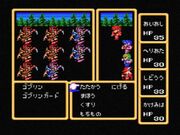
A battle in the MSX2 release.
The MSX2 computer standard was roughly analogous, in terms of technical capabilities, to the Famicom, and so, as a result, the MSX2 version of Final Fantasy is probably the closest to the original Famicom version. However, while the Famicom was designed to operate exclusively as a gaming console, the MSX2 was intended to be used more generally as a personal computer. In practice, this meant that the game was subtly altered to take advantage of certain features offered by the MSX2 and not by the Famicom, and vice versa.
- Format - Released on floppy diskette, the MSX2 version of the game had access to almost three times as much storage space as the Famicom version (720 KB vs. 256 KB), but suffered from a variety of problems not present in Nintendo's cartridge media, including noticeable loading time.
- Altered graphics - Relatively minor upgrades. In general, the MSX2 version sports an ostensibly improved color palette which adds a degree of vibrancy to character and background graphics. However, some have commented that the choice of colors sometimes seems "off", and argue the Famicom version's graphics were of higher quality, despite the technical superiority of the MSX2 in this field.
- Subtly altered random battles - The world map seems to have been moved slightly, meaning that the placement of monster "areas" on the world map is slightly different and that monsters appear in different places than in the Famicom version.
- Different saved game system - Game data could not be saved onto the original program diskette, so it was necessary to provide a blank floppy diskette to save one's progress. It was possible to store only one saved game on any given disk at one time, although it was possible to have multiple diskettes for multiple saved games.
- Upgraded sound and music - The MSX2 featured more sound channels than the Famicom, and as such many music tracks and sound effects were altered or improved for the port. Also, some dungeon music was swapped.
- Miscellaneous engine tweaks - In the Famicom version, the Black Belt's strength would increase with his experience levels, meaning that very soon the player would reach a point where a Black Belt could do more damage without weapons than he could with one equipped. In the MSX2 version, this is not the case: Black Belt's strength does not increase nearly as quickly, and thus he cannot operate effectively as a barehanded fighter. Also, many items available in stores have had their costs changed.
Family Computer version to Nintendo Entertainment System version
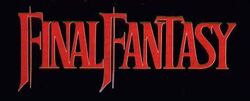
Original NES Logo.
The 1990 North American localization of Final Fantasy was essentially identical to the original Japanese game. But technical limitations, and the censorship policies of Nintendo of America, resulted in a few minor changes to certain elements.
- Truncated magic names. The original game program provided only four character spaces for magic spell names, meaning that a lot of original Japanese spell names had to be abbreviated to fit into the space requirements for the English version. These changes include "Flare" being reduced to "NUKE" and "Thunder" being reduced to "LIT."
- Censorship issues. Nintendo of America policy prohibited games from featuring any overt Judeo-Christian imagery or reference to death. As such, some graphics were modified, so that, for instance, churches no longer featured crosses.
- This is probably why the Kill spell was renamed as "Rub."
Family Computer version to WonderSwan Color version

Original WonderSwan Color logo.
Many more changes were introduced for the game's WonderSwan Color remake:
- Upgraded graphics - The 8-bit graphics of the original Famicom game were completely redrawn for the WSC version, bringing the game roughly on-par with 16-bit era graphics. The color palette was much larger and battle scenes featured full background images.
- Parity with later games - Character sprites, especially the upgraded classes, were redesigned to look more like characters from the Super Famicom Final Fantasy games. In the Famicom version, shops and inns had no interior map: once a character entered the building, they were greeted with a menu-based purchase screen. In the WSC version this was changed to more closely resemble other games in the series, where each building had an interior, along with a shop counter where the transaction screen could be accessed. Similarly, the battle screen was redesigned, with all textual information moved down to a blue window stretched across the bottom of the screen in an arrangement similar to that utilized in Final Fantasy II through Final Fantasy VII.
- Added cutscenes - Short cutscenes, using the internal game engine, were added to expand the game's story somewhat. One such cutscene involved the construction of the bridge by the Corneria army.
- Expanded text - The original Famicom version did not have the ability to display more than one window of text during a conversation, which meant that all conversations with Non-Player Characters were strictly limited in length. The WSC version removes this restriction.
- Optional engine tweaks - In the original version, any attempt to attack a monster that had been killed by a previous character's attack would result in an "ineffective" attack. The WSC version introduced an option wherein the attack would be redirected to another monster rather than fail. Similarly, a "dash" option had been introduced: holding down a specific button while walking around in a town or dungeon map would cause the character to move around at twice their normal pace. Both of these options can be turned on and off via the game's configuration screen.
- Deletable spells- In the original version, every magic-using character has successive "spell levels". Each character has only three available slots per spell level, but is given the option of choosing from four spells. Once that choice had been made in the original version, there was no way to "unlearn" spells to free up a space for the unchosen fourth spell. In the WSC version, this has been changed so that it is possible to delete spells once purchased.
- More save game slots - The original Famicom cartridge could only store one set of game data at a time, and every time a new save was made, the previous one was overwritten. The WSC version provides up to eight distinct slots for saved game data. The "quick save" feature was also added, which allows the player to save his or her progress at any time, except during battles. This will exit the game, however, and as soon as the game is resumed, any quick save data is lost.
- Changed item system - In the original version, only items specifically assigned to a character could be used during battle. In the WSC, this has been changed so that there is a party-wide "pool" of items which can be accessed at any time by all characters. Certain status healing items and spells (such as Life and Soft) could now be used during battle. The status ailment Silence no longer prevents items from being used.
- Added music - In addition to remixing the soundtrack, composer Nobuo Uematsu has composed several new tracks, including a new "boss battle" theme.
- Bosses have more HP - Because many of the above changes make the game simpler, the hit points of certain monsters, and almost all boss monsters, have been substantially increased (and doubled in some cases) in order to better balance the gameplay.
WonderSwan Color version to Final Fantasy Origins
The PlayStation remake of Final Fantasy was released alongside its sequel, Final Fantasy II, in a collection titled Final Fantasy Origins (or Final Fantasy I+II Premium Collection in Japan). Both of these games were based on the WonderSwan Color remake, and most of the changes instituted in that version remain.
However, there are a few differences:
- Higher resolution graphics - Although the graphics are basically the same as in the WSC version, the PlayStation's higher screen resolution means that most of them have been improved to some degree, with quite a bit more detail.
- Remixed soundtrack - Nobuo Uematsu remixed the soundtrack to Final Fantasy IX quality to utilize the Sony PlayStation audio capabilities and also composed a few new tracks like the ones used in the opening movies.
- Rewritten script - In the Japanese language version, the script has been changed to include kanji. The English language translation, too, has been completely rewritten, and is, in most cases, much closer to the Japanese than the original English NES version was. Also, character and magic name lengths have been increased from four to six characters.
- Even more saved game slots - Saved game data takes up one block on the PlayStation memory card, which means that up to fifteen games can be saved onto each memory card. The "quick save" feature of the WSC version has been excised, but in its place a "memo save" feature has been introduced where game data can be temporarily saved to the PlayStation's RAM. This data remains until the system is turned off, or its power supply is otherwise interrupted.
- Added full-motion video cutscenes and omake - The game is now book-ended with two full-motion, prerendered video cutscenes. An "omake" (or bonus) section has also been made available. It includes a bestiary, an art gallery, and an item collection that are unlocked as the player progresses through the game.
- New "Easy Mode" - A new "easy mode" has been introduced wherein shop prices are cheaper, experience levels are gained more quickly, and stats are increased more rapidly. This mode is optional and is chosen at the start of the game.
Final Fantasy Origins to Final Fantasy I & II: Dawn of Souls
Another fairly extensive list of changes accompanies the Game Boy Advance release of Final Fantasy as part of Final Fantasy I & II: Dawn of Souls.
Among them are:
- Reduced difficulty level - The GBA version's difficulty level most closely resembles the "easy mode" of the PlayStation/Final Fantasy Origins version. Unlike that version, however, there is no option to switch back to the original difficulty. Similarly, the redirection of "ineffective" hits, which had been optional since it was introduced in the WSC version, is now mandatory.
- Lower resolution graphics - compared to the PlayStation version. Graphics are of similar quality to the WSC version, although the GBA has a slightly higher screen resolution than the WSC, and certain sequences (such as flying around on the airship) look better on the GBA than on the WSC.
- New magic system - The "spell level"-based magic system was dropped in favor of the magic point-based system used in more recent Final Fantasy games. Although spells are still classified at certain levels for some purposes (characters can still only be equipped with three of the four available spells of any given level, for instance), every spell is now assigned a point value. When cast, that value is subtracted from a total number of magic points (or MP) that applies to all spells known by a character.
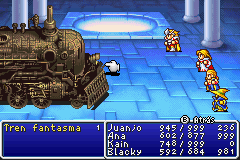
The Phantom Train from Dawn of Souls (Spanish version).
- New item system - Many new items have been introduced, including the reviver item Phoenix Down. Healing items are now much easier to procure and less expensive, as well. The party starts the game with 500 gil instead of 400 as in previous versions. The player can also now obtain Item Drops from enemies.
- Omake bestiary - The omake artwork gallery and item collection present in the PlayStation version have been omitted, but the bestiary gallery remains and operates in much the same way as it did previously.
- Miscellaneous game engine tweaks - Certain classes have been modified: the Thief and Monk have become more powerful, whereas the Red Mage has become less so. Stat Growth has been altered, and Intelligence now affects the strength of weapon-based magic spells.
- Altered save system - The game can now be saved at any time, anywhere (again, except during battles). There are three available save game slots.
- Monsters have even more HP - Because the introduced changes make the game even less challenging, many monsters and boss monsters have had their hit points increased once again.
- "Auto-naming" - During character creation, the player can choose to have the game randomly assign a name to each character. These names are all taken from other Final Fantasy games and include Desh (Final Fantasy III), Giott (Final Fantasy IV), Kelga (Final Fantasy V), and Daryl (Final Fantasy VI), among others.
- Soul of Chaos - Four new optional dungeons have been introduced, one corresponding to each Fiend, and become available after that Fiend is defeated. These dungeons are especially challenging and feature items and monsters not found anywhere else in the game. At the end of each dungeon there are a variety of boss monsters from subsequent games in the Final Fantasy series, including the bosses from the World of Darkness from Final Fantasy III, the Archfiends from Final Fantasy IV, the bosses from the Cleft of Dimension from Final Fantasy V and the bosses from Final Fantasy VI.
Final Fantasy 20th Anniversary Edition
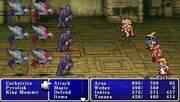
A battle in the Anniversary Edition.
In honor of the 20th Anniversary of the first Final Fantasy game's release, Square announced another remake, this time for the PlayStation Portable. The soundtrack is borrowed from Final Fantasy Origins. The script is nearly identical to the GBA version aside from the Labyrinth of Time.
The known changes and features are:
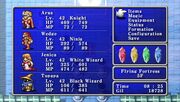
Main menu of the Anniversary edition.
- Higher resolution - The graphics have been updated once again and more detailed. Aerial effects have been added to the towns and dungeons.
- Soul of Chaos Dungeons - The new dungeons from the Dawn of Souls version remain in this version. The music tracks from boss battles were also changed to the tracks of the games the new bosses originated from, which consists of five new tracks.
- The Labyrinth of Time - The new dungeon with much greater difficulty than any other in the game and its new superboss surpasses even Omega, Shinryu, and Chaos in difficulty.
- Amano art gallery - The art gallery featured on Final Fantasy Origins has returned on this version.
- CGI Scenes. The CGI scenes from the PlayStation version have returned.
Final Fantasy for smartphones

A battle in Final Fantasy on iOS.
The port of the original and second Final Fantasies to the iOS is available in Apple's App Store for $8.99/£5.50. Both games have graphics similar to the Anniversary Edition and their special dungeons. With a single purchase, both the English and Japanese language versions of the games are made available (through the phone's system language). The original Final Fantasy's gameplay remains the same as in the PlayStation Portable port, while Final Fantasy II iOS version adds new gameplay elements, mainly the implementation of touch controls. However, the Window Color option has been removed, and the Art Gallery can no longer be featured on any smartphone versions. The music quality of both Final Fantasies is also slightly worse in comparison to the Official Soundtrack version (which is fully preserved on the PSP Anniversary editions, quality-wise).
The Apple iOS version of Final Fantasy includes a "quick save" that allows the player to save the party's current location either on the overworld map or in dungeon mode when the application gracefully exits. This means that when gameplay is interrupted by returning to the home screen, receiving a phone call, or putting the device in sleep mode and subsequently syncing the device (which resets the device's current status), the game will resume in the same location when "Resume" is selected at the opening screen. However, if the player chooses to open a save file or new game, the data is deleted.
A port of the iOS version of the game to Microsoft's Windows Phone platform was made available on the Windows Phone Marketplace in Japan on 4 June, 2012, and America and Europe on 13 June, 2012. Features unique to this version include a phone status indicator (time, signal, WiFi status and battery level) on the left or right side of the screen (depending on device orientation) and Xbox Live Achievements.
As with apps for the platform, a demo of the Windows Phone version is available. The main difference from the full version of the game is that upon reaching the drawbridge and watching the introduction to the game proper, gameplay is halted and a message appears, stating "This concludes the Demo. Buy the Full Game to play on!". Touching the screen here returns the player to the title screen. Another feature of the demo version is an option in the title screen menu which offers a direct link to the app listing in the WP Marketplace, where they can purchase the full version.
Final Fantasy was made available on the Google Play store 27th July, 2012. It is similar to the iOS and the Windows Phone 7 version, both of which are based on the PlayStation Portable remake, but does not include any of the bonus dungeons which were not in the original game. Final Fantasy on Android is available for $6.99 / £4.44 in the Google Play store and runs on Android 2.1-compatible devices and up.
- iOS version (v1.0.3) available here (UK, £5.99), here (US, $8.99); 81.5 MB.
- Windows Phone version (v1.0.0), available here (UK, £5.49), here (US, $6.99); 90 MB.
- Android version (v.2.2), available here; 46.4 MB.
Final Fantasy Mobile
Namco released a mobile port of Final Fantasy worldwide as a Java game.
Gameplay is based on the NES release, but with a few noticeable differences:
- Bugs present in the NES version were largely fixed, with exception to commonly retrofitted "bugs" such as the Peninsula of Power and miscalculated critical hits.
- A re-translated script.
- An expanded inventory system, allowing the player to carry every item present in the game.
- A quicksave function that may be toggled off and on. The game saves to a separate quicksave slot whenever the player enters a new room or floor, and the file is erased upon being loaded. In difficult dungeons, this feature can be exploited by stepping out of the room or entering the last set of stairs, then re-entering to ensure the quicksave file is not erased. If the party is slain or the player needs to reset, the quicksave file may be used to retain the player's position in the dungeon.
- Dashing and re-targeting, both of which may be toggled off and on (similar to the WSC and Origins versions).
- Some enemy groups have been rearranged. Stronger enemies are sometimes encountered much earlier in the game.
- The Knight and Ninja classes no longer have their MP (or spell charges) capped at 4. Both may advance as high as 9 charges per spell level.
- Chaos's HP is doubled, compared to his NES counterpart.
Sound effects are absent from the game, but the player may choose to turn background music off and on. BGMs consist simple MIDI arrangements with no looping points, and there are no boss themes, save for the battle with Chaos. The graphics are a compromise between the GBA and NES versions, having detailed sprites, but retaining more generic map and dungeon tiles similar to those used in the NES release.
Hi-Potions, Phoenix Downs, and other items introduced in the GBA version are not present. The player must make do with standard Potions, Antidotes, Gold Needles, Sleeping Bags, Tents and Cottages. No hidden extras are featured in this port. Clearing the game only displays the ending sequence, with no option to save and begin a New Game Plus file.
Namco's version is typically priced around $4.99, or 4€ and it is 600 KB large.
Novelization
As part of its Final Fantasy 25th anniversary celebration, Square Enix released a novelization of the first three Final Fantasy games. The novelization titled Novel Final Fantasy I, II, III Memory of Heroes was released Fall 2012.
Production credits
Original Famicom Version
- Original Concept & Lead Designer - Hironobu Sakaguchi
- Co-Designers - Hiromichi Tanaka, Akitoshi Kawazu, Koichi Ishii
- Character Design - Yoshitaka Amano
- Programmer - Nasir Gebelli
- Co-Writer - Kenji Terada
- Music - Nobuo Uematsu
While not credited in-game, the following individuals are also known to have worked on the game:
- Producer - Masafumi Miyamoto
- Battle Planner - Hiroyuki Ito
- Sprite Artists - Kazuko Shibuya, Takashi Tokita
- Assistant Programmers - Ken Narita, Kiyoshi Yoshii
- Sound Programming & Sound Effects - Toshiaki Imai
- English Localization - Kaoru Moriyama
Final Fantasy Origins
- Executive Producer - Yoichi Wada
- Original Staff
- Program - Nasir Gebelli
- Scenario - Kenji Terada
- Character Design - Yoshitaka Amano
- Original Development - Hironobu Sakaguchi, Hiromichi Tanaka, Akitoshi Kawazu, Kouichi Ishii, Kazuko Shibuya, Nobuo Uematsu, Kiyoshi Yoshii (Final Fantasy), Ken Narita (Final Fantasy), Katsuhisa Higuchi (Final Fantasy II)
- Remake Staff
- Producer - Yusuke Hirata
- Directors - Hideshi Kyonen (Final Fantasy), Katsuyoshi Kawahara, Kazuhiko Yoshioka
- Designers - Sentaro Hotta, Tomohiko Tanabe, Hideto Oomori, Mieko Hoshino, Kumiko Fujiwara, Eiji Yamashita, Hisanori Tani, Yoshihisa Maeda, Tohru Honda, Yoshisuke Nkahara, Keisuke Motozono, Hiroko Watanabe
- Movie Director - Koji Wakasono
- Movie Designers - Mitsuhiro Yamada, Satoshi Sumida, Masato Motoki, Yutaka Maekawa, Wataru Ikeda, Shin Azuma, Rumiko Sawada
- Movie Programmer - Naoto Uenaka
- Movie Coordinator - Shiho Sasaki
- Sound Programmer - Minoru Akao
- Music - Tsuyoshi Sekito
- Sound Editors - Masataka Saito, Tomohiro Kamiya
- Movie Sound Editor - Eiji Nakamura
- Movie Dialogue Editor - Teruaki Sugawara
- Music Supervisor - Nobuo Uematsu
- Voice Section - Half Hip Studio
- Firion - Yukimasa Obi
- Leon - Takayuki Yamaguchi
- Gus - Kenta Miyake
- Maria - Noriko Shitaya
- Mixer - Nobutaka Hirooka
- Recordist - Nobuhira Hirano
- Studio Booking - Toru Nakano
- Coordinators - Kiyomi Tanikawa, Rie Nishi, Miwa Maki
- Quality Management Division - Akihito Shoji, Hironori Akiyama, Kenichi Miyake, Hiromitsu Sato, and all QA Staff.
- Ratings Section - Reiko Kondo
- Porting - KAN NAVI Corp.
- Localization Staff
- General Manager - Akira Kashiwagi
- Localization Directors - Tomoko Sekii, Kazuyoshi Tahiro
- Localization Programmer - Yoshinori Uenishi
- Localization Assistant - Satoko Kondo
- Special Thanks - Masashi Kouda, Masashi Nakamichi, Yasuhiro Maeda, Hideki Matsuoka, Katsunori Kataoka, Satoshi Murakami, Toshimi Kahara, Toshiaki Naito, Tetsuya Okamoto, Yasuhiko Kyo, Mitsuhiro Yamada, Miki Akakura, Yoshie Nishimura, Mika Okada, Sakiko Kuniyoshi, Yoshiya Hirohama, All Square Staff.
- Square Enix, Inc.
- Localization - Jennifer L. Mukai, Yutaka Sano
- Quality Assurance - David Carrillo, Mohammed A.C. Wright, Aaron J. Adams (Lead Product Analyst/ Final Fantasy), Mathew Clift (Lead Product Analyst/ Final Fantasy II), Jonathan Cooperson, Dana J. Kwon
- Customer Support - Ryan Riley, Anthony Montana
- Marketing Communications - Kyoko Yamashita, Sonia Im
- Marketing - Kenji Mimura, Keiko Kato, Fernando Bustamante, Patrick H. Cervantes
- Sales - Sean Montgomery, Alaine C. Deleon
- Business Development - Ken Berry
- Senior Vice President & CFO - Kenzo Nogimura
- President & CEO - Jun Iwasaki
- Special Thanks - The Kenwood Group, Ruder Finn, Virtual Interactive, Inc., Joel G. Clift, Jaime J. Bencia, Yuji Shibata
Final Fantasy I & II: Dawn of Souls
Final Fantasy 20th Anniversary Edition
- Executive Producer - Yoichi Wada
- Producer - Yusuke Hirata
- Production Manager - Kiyomi Tanikawa
- Directors - Hideshi Kyonen, Katsuyoshi Kawahara, and Kazuhiko Yoshioka
- Movie Director - Koji Wakasono
- Movie Designers - Mitsuhira Yamado, Satoshi Sumida, Masata Motoki, Yutaka Maekawa, Wataru Ikeda, Shin Azuma, and Rumiko Sawada
- Movie Programmer - Naoto Uenaka
- Original Music - Nobuo Uematsu
- Graphics - Yoshisuke Nakahara, Mieko Hoshino, Tomohiko Tanabe, Hideki Omori, and Eiji Yamashita
- Testing - Reiko Kondo
- Localization Manager - Akira Kashiwagi
- Localization Directors - Tomoko Sekii and Kazuyoshi Tashiro
- Localization Programmer - Yoshinori Uenishi
- Localization Specialist - Amanda J. Katsurada
- Localization Assistant - Satoko Kondo
Packaging Artwork
Template:Gallery
Gallery
Template:See Also Template:Gallery
Trivia
- In Final Fantasy IV: The After Years, the Four Fiends are guardians for the True Moon crystals.
- Supposedly, the world of Final Fantasy did at one point have summons, as shown in Dissidia Final Fantasy, but Chaos banished them into the Interdimensional Rift.
- The original Famicom release and MSX versions had some different graphics. Two of the most obvious changes are done to two types of monsters — the Medusa enemies were originally topless, while the Eye enemies were originally Beholders from Dungeons & Dragons. Later versions changed this, even the Japanese Final Fantasy I & II Famicom art. The Beholder graphic was restored in Dissidia Final Fantasy as player icons, but the revised graphics for Master, Red Wizard and White Wizard remain.
- Some of the recurring aspects of the Final Fantasy series did not appear until later on. The original Final Fantasy did not feature a character named Cid until Cid of the Lufaine was first mentioned in the Dawn of Souls remake. Since chocobos were only introduced in Final Fantasy II, this is also the only game not to feature chocobos, and is one of only three main series games not to feature moogles, as these were only introduced in Final Fantasy III (with them being absent in Final Fantasy II and Final Fantasy IV as well).
- The NES edition had a sly reference to the other major RPG of the time, Dragon Warrior. In the city of Elfheim, one headstone reads "Here lies Erdrick", Erdrick was referenced often in the original Dragon Warrior, and is the protagonist of Dragon Warrior III. This reference was originally to Link, the protagonist of The Legend of Zelda series. It was changed back in later editions including Final Fantasy Origins, the Dawn of Souls version, and Final Fantasy 20th Anniversary Edition for PSP and iOS. Additionally, many of the elves seen in the PSP version have an uncanny resemblance to Link.
See Also
- Final Fantasy Concept Art
- Final Fantasy Translations
- Final Fantasy Version Differences
External Links
- Final Fantasy I・II Advance Official Site (Japanese)
- Final Fantasy 20th Anniversary Official Site (Japanese)
- Final Fantasy for Mobile Official Site (Japanese)
- Final Fantasy Origins Official Site (North American)
- Final Fantasy mobile (Namco) Official Site
- Final Fantasy I・II Dawn of Souls Official Site (North American)
- Final Fantasy 20th Anniversary Official Site (North American)
- iTunes Store Purchase Page
- Googleplay Purchase Page
- Wikipedia's entry on the original Final Fantasy
- Final Fantasy Classic, a site dedicated to this game
- Caves of Narshe Final Fantasy I Collection
- Final Fantasy I Shrine
- Final Fantasy Mages
References
Template:FFI
Template:20thcomplTemplate:25thcompl Template:Series
ar:Final Fantasy I eo:Final Fantasy

